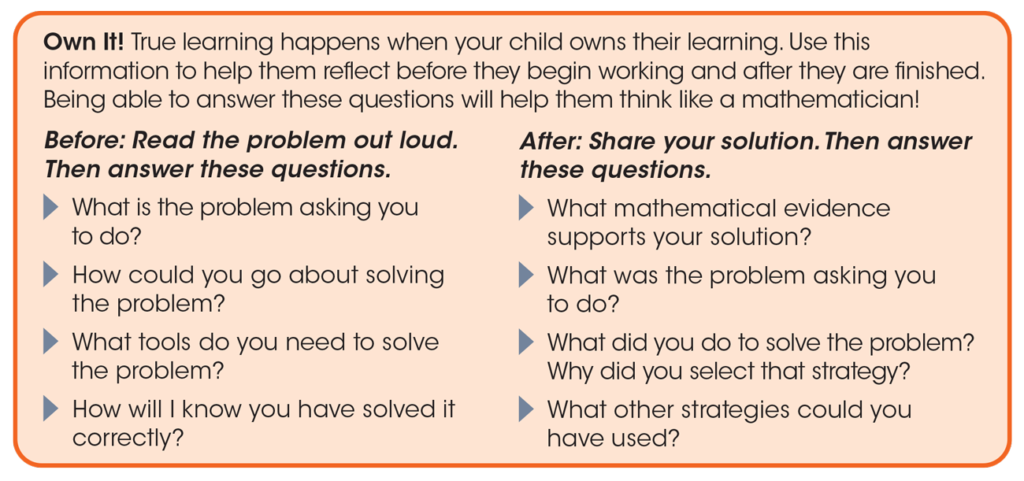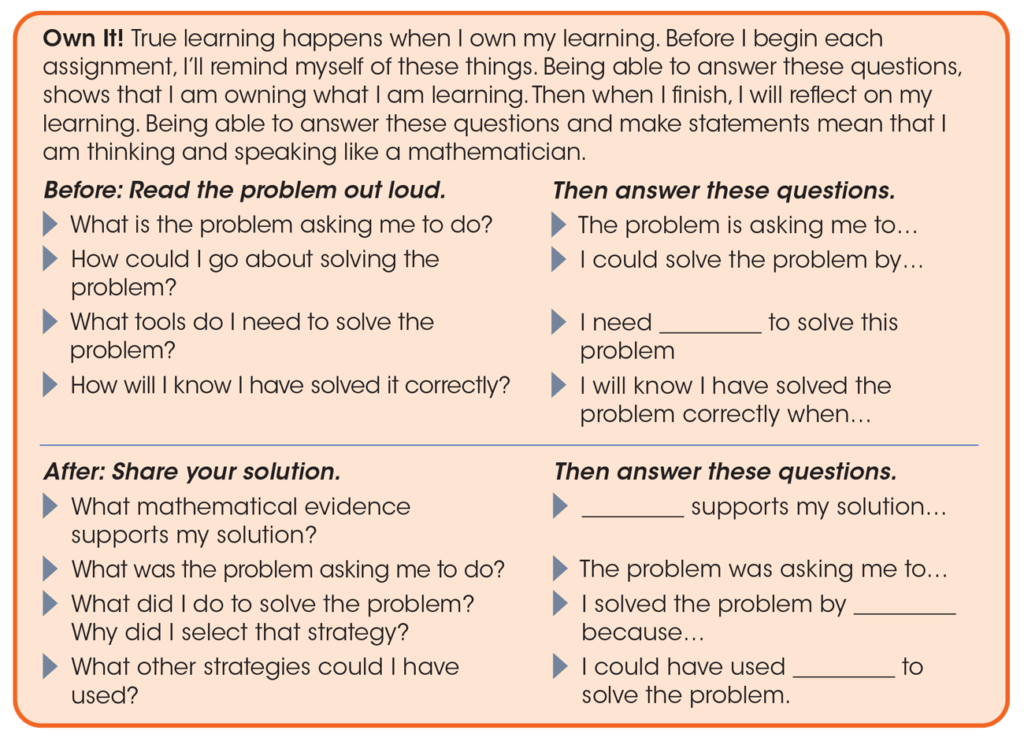Share this article.
Learning at home is important because teachers can’t do it alone. We need to ensure that the students are motivated to be active participants in their own learning and that parents and caregivers are empowered to support their children in their learning. You can do this by supporting your child’s ownership of learning at home when you understand the importance of student ownership in mathematics, your role in developing it, and how to empower your child to own it.
Student Ownership in MATHEMATICS Is Key
Mathematics is much more than just solving the problems and checking to see if the answer is correct. It also involves each student’s understanding of what they are learning, how they can learn it, and what they have learned about their mathematical thinking along the way.
“One hallmark of mathematical understanding is the ability to justify, in a way appropriate to the student’s mathematical maturity, why a particular mathematical statement is true or where a mathematical rule comes from. There is a world of difference between a student who can summon a mnemonic device to expand a product such as (a + b)(x + y) and a student who can explain where the mnemonic comes from. The student who can explain the rule understands the mathematics, and may have a better chance to succeed at a less familiar task such as (a + b + c)(x +y).” (National Governors Association, 2013)
In other words, the more students are able to understand their own learning process and talk about it, the easier it will be for them to improve their mathematical understanding and problem-solving skills. This is mathematical metacognition—thinking and talking about they learn, do, and use math. When your child can intentionally think like a mathematician, talk about what they are learning in math, and reflect on how they are learning math, they are owning their learning in mathematics.
Student Ownership at Home
To support your child to own their learning in mathematics when they are at home, there are several things you or other family members need to do.
- It is imperative for you to ask your child what they are learning, so that they are able to talk about how they will determine what a math problem is asking them to do, how they will solve it, and the tools they will need.
- It is imperative for you to ask your child how they will know they are learning, so that they are able to talk about how they know they solved the problem and the mathematical evidence that proves this.
- It is imperative for you to ask your child how they will continue to use what they learned, so that they are able to talk about how thinking and speaking like a mathematician will help them.
Work with your child to build a metacognitive routine. For each and every assignment, have them reflect on their learning with the following questions before they begin working and to reflect on their learning after they have completed their work.
Before working: Read the problem out loud. Then answer these questions.
-
- What is the problem asking me to do?
- How could I go about solving the problem?
- What tools do I need to solve the problem?
- How will I know I have solved it correctly?
After working: Share your solution. Then answer these questions.
-
- What mathematical evidence supports my solution?
- What was the problem asking me to do?
- What did I do to solve the problem? Why did I select that strategy?
Questions like these help students expand their thinking, develop metacognitive skills, and become more aware of their own strengths and weaknesses. You will help them think and speak like a mathematician by having them routinely answer these questions as they work.
Tools for You that Build Metacognitive Routines
Ultimately, we want all students to automatically think about, question, answer, and follow this routine for every math assignment. But for many kids they need us to model first and support them as they practice until they do this independently. So, at the beginning, you will need to lead this question and answer. You can start by using this “Own It!” guide for parents and caregivers.

As your child work, encourage them to…
- Share their thinking about mathematics with you and/or other family members and discuss what they are thinking.
- Be okay with not knowing every answer, especially in the beginning. Deep learning occurs when there is a little struggle to get there.
- Keep reflecting. Thinking and speaking like a mathematician takes practice. Don’t let them give up.
Then as your child becomes more independent and regularly using the routine with little prompting from you, give them this “Own It!” guide for students as a reminder to keep thinking and speaking like a mathematician.

Our Role in Supporting Student Ownership at Home
Whether it’s mathematics or reading or another content-area, we know that learning, and the skills of learning, transcend beyond the classroom walls. The students themselves become the most effective advocates for their learning when they possess the skills to take ownership of it. But, it is our role and responsibility as the adults to support our students by helping them develop their skills of ownership. We invite you to check out our other resources for parents and caregivers that will help you help your child.
Continue the Learning
Check out these articles and resources to continue your learning about this topic…
The Learning Brief
In this article you learned…
- Mathematical thinking (metacognition) is crucial for mathematical success.
- Parents and caregivers can support students to be mathematical thinkers, even when they are at home.
- How to use a series of questions and sentence frames that push your child’s mathematical thinking and speaking skills.
Can you imagine building an environment full of motivated, engaged, and eager students who own their learning?
We can.

